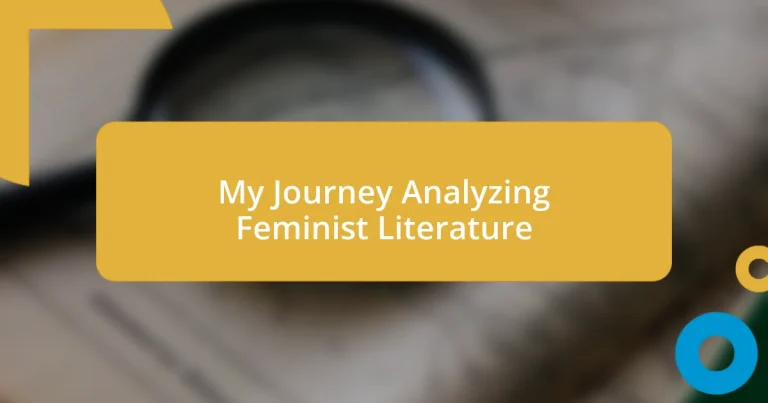Key takeaways:
- Feminist literature offers a diverse lens to understand gender dynamics, emphasizing the importance of women’s voices and narratives throughout history.
- Key feminist theorists like Simone de Beauvoir and Judith Butler challenge traditional notions of gender, encouraging a deeper exploration of identity and societal constructs.
- Common themes in feminist works include the exploration of identity, critique of traditional gender roles, and the importance of sisterhood and solidarity among women.
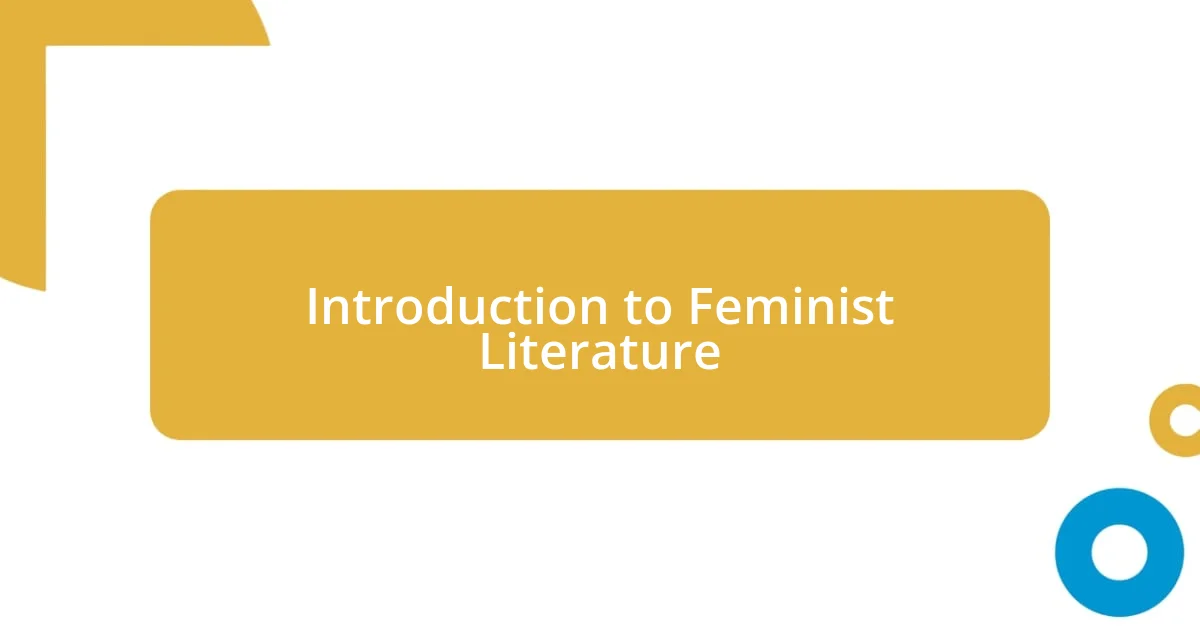
Introduction to Feminist Literature
Feminist literature isn’t just a genre; it’s a powerful lens through which we can view and understand the complexities of gender dynamics. I remember reading Virginia Woolf’s A Room of One’s Own for the first time. It struck me how her call for women’s independence resonated beyond her time, prompting me to question: Why are women’s voices often overshadowed in literary history?
As I delved deeper into feminist literature, I encountered works that vividly illustrated women’s struggles and triumphs. Books like The Handmaid’s Tale by Margaret Atwood didn’t just entertain; they compelled me to reflect on the societal norms we often take for granted. Hasn’t every woman felt, at some point, the weight of expectations that constrain her identity?
What I find fascinating is the diversity within feminist literature itself. It encompasses narratives from different cultures, races, and backgrounds, shaping a richer dialogue around feminism. Reading authors like bell hooks and Toni Morrison opened my eyes to perspectives I hadn’t considered before, prompting me to rethink my own experiences. This exploration is not just academic; it’s personal, as each story adds layers to my understanding of what feminism means today.
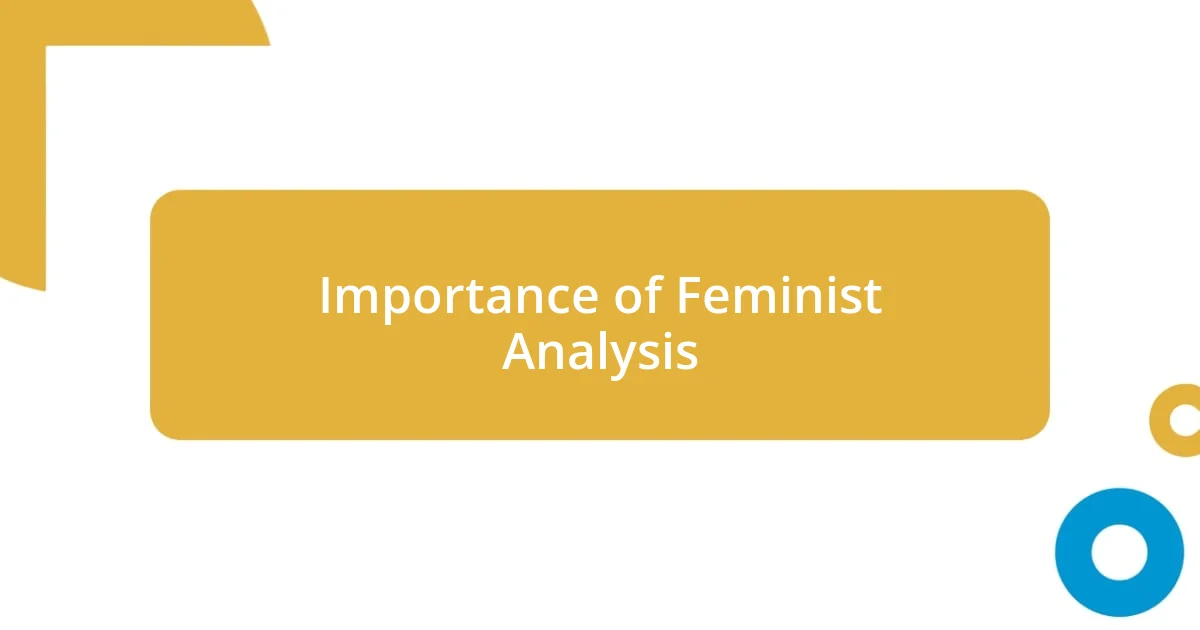
Importance of Feminist Analysis
Feminist analysis is crucial because it provides a framework for understanding the systemic inequalities present in societal structures. I recall sitting in a literature class, analyzing Charlotte Perkins Gilman’s The Yellow Wallpaper. It became undeniable to me how deeply ingrained patriarchy affects women’s mental health. This text invited me to consider how the confinement of women—both physically and mentally—can manifest and persist in modern contexts.
Additionally, examining literature through a feminist lens helps to reclaim women’s narratives that have often been marginalized. In my own journey, reading works like Alice Walker’s The Color Purple shed light on the intersections of race and gender. It was an emotional experience to witness the resilience of black women navigating oppression. This connection sparked a desire in me to amplify these voices, recognizing that each story contributes to a broader understanding of humanity and diversity.
Moreover, feminist analysis encourages critical thinking about the role of literature in shaping societal perceptions. I remember contemplating how mainstream media often portrays gender roles, sometimes reinforcing stereotypes. Engaging with feminist texts allowed me to question these portrayals and consider alternative narratives. It’s a continuous journey—one where literature not only entertains but inspires us to rethink our values and challenge the status quo.
| Aspect | Feminist Analysis |
|---|---|
| Purpose | Understanding systemic inequalities |
| Impact | Reclaiming marginalized narratives |
| Encouragement | Critical thinking about representations |
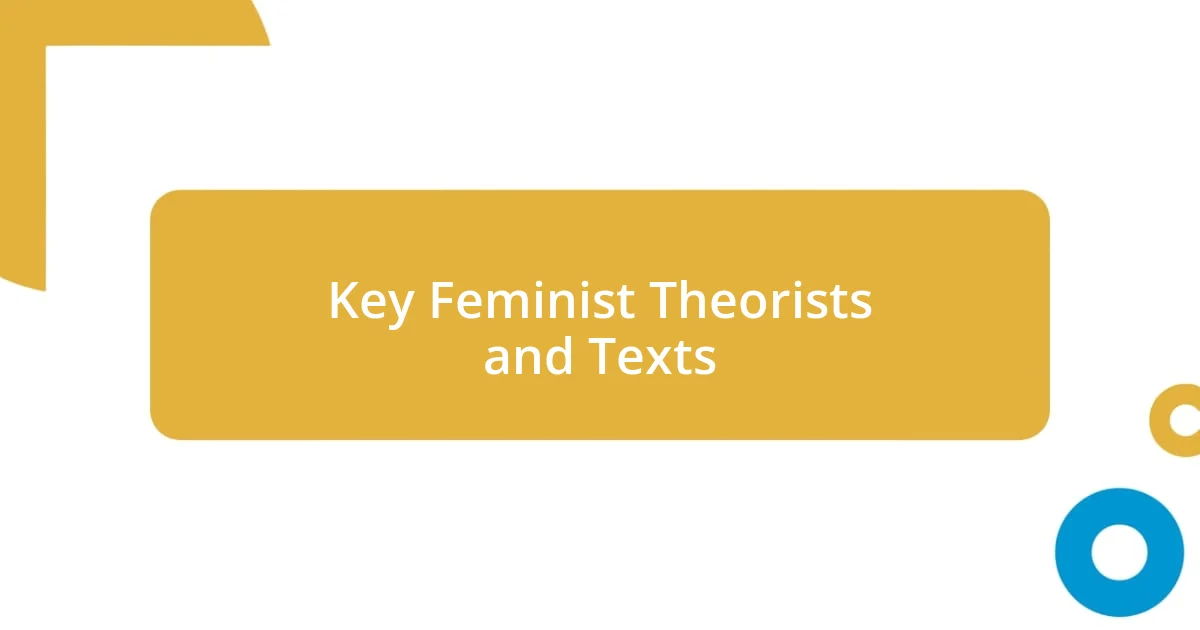
Key Feminist Theorists and Texts
In discussing key feminist theorists and texts, I can’t help but reflect on how certain works profoundly shaped my understanding of feminism. People like Simone de Beauvoir and Judith Butler challenged me to rethink gender as a social construct rather than a fixed binary. Hersey’s The Second Sex made me confront ingrained beliefs about femininity and choice in ways I had never anticipated.
- Simone de Beauvoir – The Second Sex: This groundbreaking work argues that one is not born a woman, but rather becomes one, highlighting the societal forces that shape gender identity.
- Judith Butler – Gender Trouble: Butler’s concept of gender performativity prompted me to explore how our societal roles are not inherent but rather enacted through our choices.
- bell hooks – Ain’t I a Woman?: This poignant text brought to light the unique challenges faced by black women, deepening my appreciation for intersectionality in feminist discourse.
- Virginia Woolf – A Room of One’s Own: Woolf’s argument about the necessity of both literal and figurative space for women resonated with my own desire for creative freedom.
As I engaged with these texts, I increasingly felt empowered to articulate my views on women’s rights and representation. Each theorist, with their distinct perspectives, expanded my horizon and fostered a nuanced approach to gender issues. It’s hard to overstate how personally invigorating it was to realize that my voice—like those of the theorists I read—could contribute to this ongoing conversation about equality and identity.
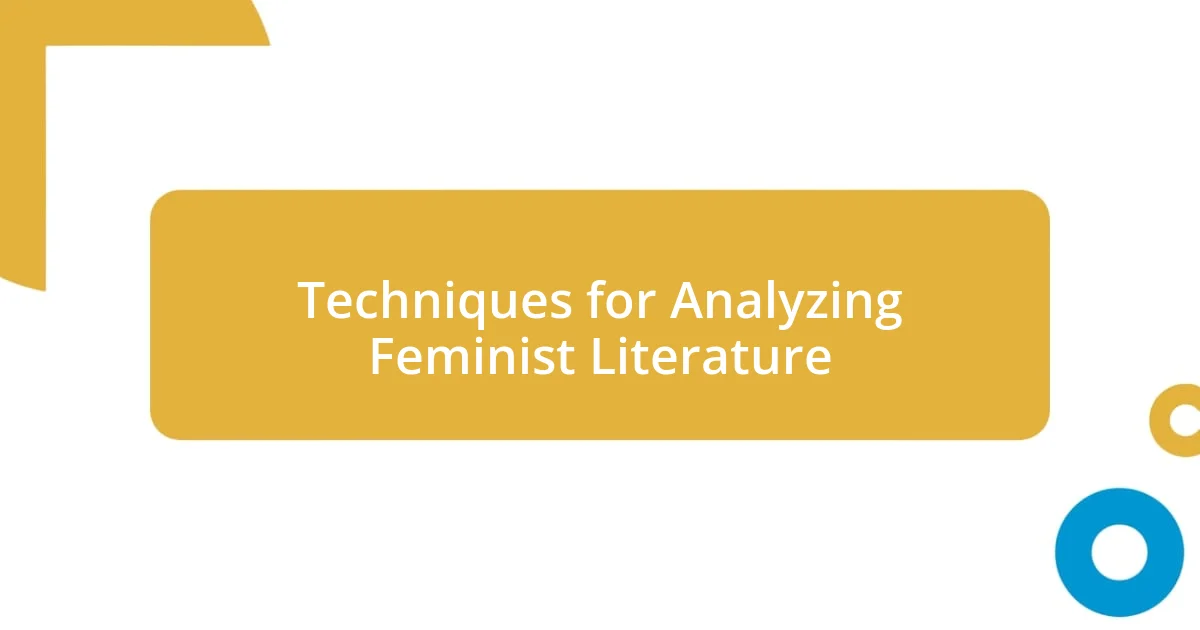
Techniques for Analyzing Feminist Literature
When diving into feminist literature, I find that focusing on character development can reveal layers of gender dynamics and inequalities. For instance, while reading Margaret Atwood’s The Handmaid’s Tale, I couldn’t help but analyze how Offred’s identity is shaped (or stripped away) by the societal norms surrounding her. This kind of close reading not only illuminated her struggle for autonomy but also sparked a reflection on the roles women are often forced into. Have you ever considered how deeply characters resonate with our own experiences?
Another technique I often employ is exploring the historical and cultural context of a text. When I first encountered Zora Neale Hurston’s Their Eyes Were Watching God, I knew I had to understand the post-Reconstruction era to grasp Janie’s journey fully. It’s fascinating how the socio-political landscape influences literary expression. This historical lens led me to appreciate how each character navigates their reality, providing a richer experience that echoes the broader struggles for equality. How can we appreciate a story without knowing the world it inhabits?
Lastly, I encourage utilizing intersectionality to dissect how various identities intertwine within a narrative. My experience with Chimamanda Ngozi Adichie’s Americanah highlighted this perfectly; it intricately weaves race and gender in a global context. As I probed deeper into Ifemelu’s experiences, I felt compelled to think about my own place within these intersections. What complexities arise when we see a character’s struggles as a tapestry of various identities? This nuanced perspective not only enhances our literary engagement but also fosters empathy and understanding for diverse experiences.
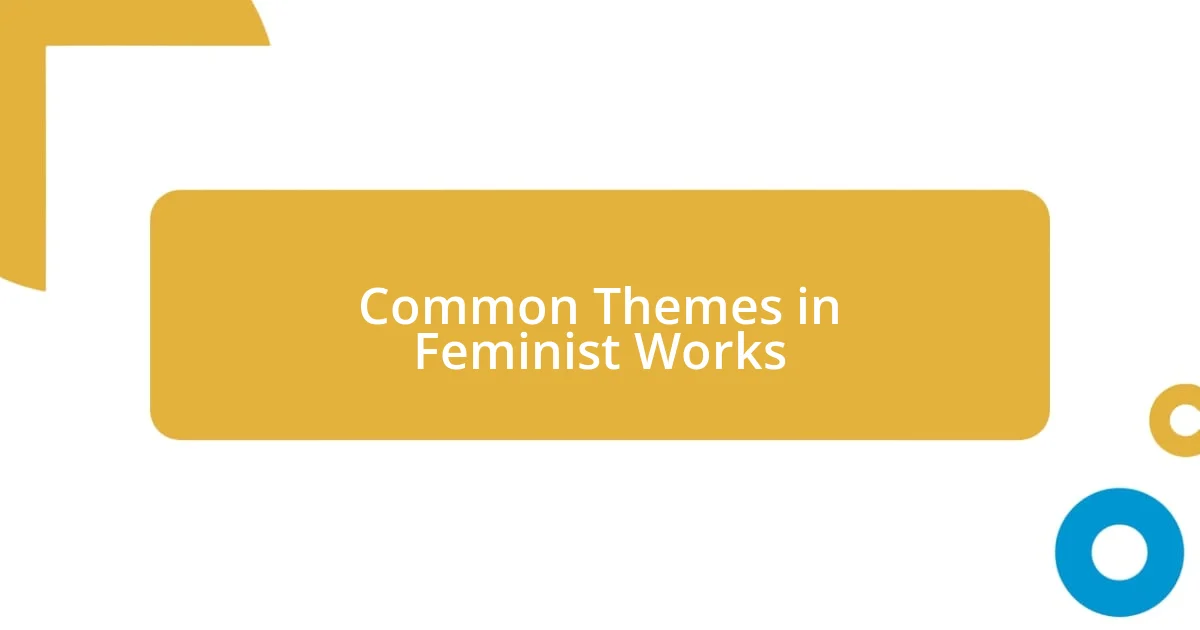
Common Themes in Feminist Works
When I delve into feminist literature, one common theme that stands out is the exploration of identity and the quest for self-authenticity. I remember feeling particularly moved by Alice Walker’s The Color Purple, as Celie’s journey toward finding her voice resonated deeply with my own struggles for self-expression. Have you ever pondered how stories of personal liberation can reflect broader societal issues? It’s almost as if those narratives invite us to reclaim our power amidst oppression.
Another prevalent theme in feminist works is the critique of traditional gender roles. Reading works like The Bell Jar by Sylvia Plath, I found myself reflecting on how societal expectations can suffocate creativity and individuality. The stigma surrounding female ambition often hits close to home. As I followed Esther Greenwood’s descent into despair, I couldn’t help but relate to the pressure of conforming to conventional paths. How often do we find ourselves battling against the weight of societal norms?
Lastly, I’m continually struck by the theme of sisterhood and solidarity among women. In books like The Joy Luck Club by Amy Tan, the bonds between generations of women illuminate the strength found in shared experiences. This theme reminds me of my own relationships with female friends where we empower each other through our struggles and triumphs. Isn’t it heartening to realize that we’re not alone in our journeys? There’s an undeniable comfort in knowing that through literature, we can connect not just with characters, but with a broader community of women navigating similar paths.
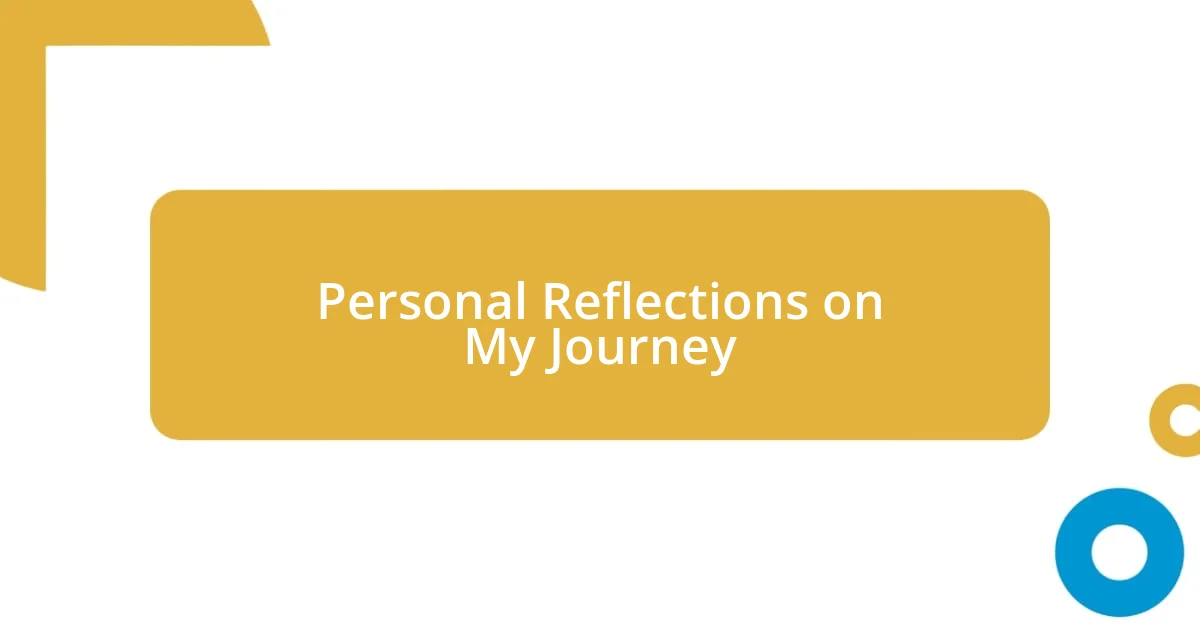
Personal Reflections on My Journey
As I reflect on my journey through feminist literature, I can’t help but think about how each book peeled back layers I didn’t know existed. I still vividly remember reading Virginia Woolf’s A Room of One’s Own and feeling a sense of liberation wash over me. The idea that I needed space—both literally and metaphorically—to express myself resonated so deeply. Can you recall a moment when a piece of writing shifted your perspective about your own creativity?
There were times when I encountered characters that seemed to echo my own insecurities and fears, which made the connections so real. In reading The Well of Loneliness by Radclyffe Hall, I felt the weight of societal rejection alongside Stephen Gordon. It wasn’t just her struggle; it felt like my own, embedded in the pages as I navigated my identity. Have you ever had that startling clarity where a character’s plight mirrors your personal battles?
Looking back, I realize how much feminist literature has shaped my understanding of resilience and vulnerability. Just as Maya Angelou’s I Know Why the Caged Bird Sings opened my eyes to the intersections of race, gender, and trauma, it urged me to confront my own struggles with vulnerability. Each encounter with these powerful narratives made me appreciate the shared experiences of women across different backgrounds. How can we not feel a sense of kinship when we recognize our stories reflected in the struggles of others?












